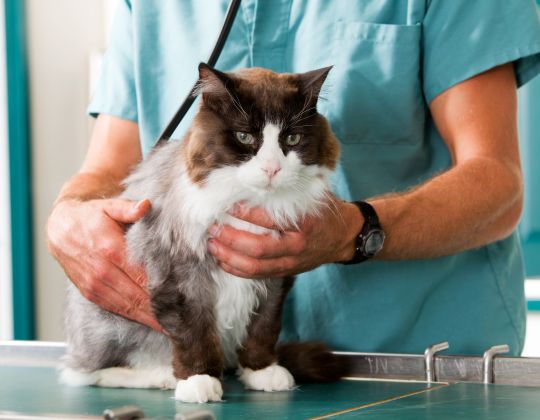Understand meloxicam before giving it to your cat because your cat deserves pain relief that’s safe.
When your cat is in pain, it’s not always easy to tell. Whether they’re recovering from surgery, dealing with arthritis, or just not acting like themselves, your vet may recommend meloxicam. A drug known as Metacam for pets and Mobic in humans. What should you know before using meloxicam for cats?
Meloxicam is a vet-prescribed NSAID used for short-term pain relief in cats. Oral use is off-label and can be risky if not closely monitored. Always follow your vet’s instructions and never use the human version, Mobic.
Here’s what you need to know to use meloxicam safely in cats, and how it works.
What is Meloxicam and How Does It Help?
Meloxicam is a type of medication known as a nonsteroidal anti-inflammatory drug, or NSAID. It’s used in cats to ease discomfort caused by swelling, tissue damage, or joint issues.
When a cat gets hurt or develops inflammation, the body responds by producing certain substances that lead to pain, swelling, and sometimes fever. One group of these substances is called prostaglandins.
Meloxicam helps by slowing down the enzyme that triggers the production of prostaglandins. This action reduces inflammation, makes pain more manageable, and may also help lower a fever if present.
How does Mobic work?
Meloxicam works similarly to Mobic, the human version, by targeting the enzymes that produce prostaglandins. These are the chemicals that cause pain and inflammation. That’s how Mobic works in humans, and why its veterinary form is used in cats.
Why Do Vets Prescribe Meloxicam for Cats?
Vets prescribe meloxicam for cats to relieve short-term pain and inflammation. It’s commonly used after surgeries, dental procedures, or injuries to reduce swelling and discomfort.
In some cases, it may also be used off-label for managing arthritis in cats.
Meloxicam helps improve mobility and comfort by easing joint stiffness and controlling the body’s inflammatory response.
Is Oral Meloxicam Safe for Cats?
Oral meloxicam can be safe for cats when prescribed and closely monitored by a veterinarian. In the U.S., it’s only approved for a one-time injection, but vets may use oral meloxicam off-label for short-term relief.
The typical off-label oral dose is 0.05 mg per kilogram of body weight once daily, usually for no more than a few days. Long-term use can cause serious side effects like kidney damage. Never give oral meloxicam without veterinary supervision, and never use the human version (Mobic).
What Should You Do If Your Cat Misses a Dose of Meloxicam?
If your cat misses a dose of meloxicam, give it as soon as you remember.
However, if it’s almost time for the next dose, skip the missed one and continue with the usual schedule.
Never give two doses within a 24-hour period. Doubling the dose increases the risk of serious side effects.
If you’re unsure what to do or your cat has missed multiple doses, check with your veterinarian for specific guidance.
What Are the Side Effects of Meloxicam in Cats?
Meloxicam is generally safe for short-term use when prescribed by a veterinarian. Still, some cats may react to the medication. Side effects can range from mild digestive upset to serious health concerns.
Mild or Common Side Effects
- Vomiting
- Nausea
- Loose or soft stools
- Reduced appetite or skipping meals
- You can give meloxicam with food to help prevent stomach irritation. If your cat continues to feel unwell, contact your vet.
Serious Side Effects
- Kidney problems (e.g., urinating more or less than usual)
- Liver issues (e.g., yellowing of the gums, skin, or eyes)
- Persistent vomiting or diarrhea
- Black, tarry, or bloody stool
- Pale gums
- Weakness, unsteady walking, or tremors
- Seizures or collapse
If your cat shows any of these symptoms, stop giving meloxicam immediately and contact your vet or an emergency animal clinic.
How to Use Meloxicam Safely?
To reduce risk and protect your cat’s health, follow these key safety steps:
- Only use meloxicam if prescribed by a veterinarian
- Never exceed the recommended dose, even small overdoses can be dangerous
- Use the veterinary version (Metacam), not human meloxicam (Mobic)
- Limit use to short-term treatment unless your vet approves off-label use
- Monitor for side effects like vomiting, lethargy, or appetite loss
- Ensure your cat stays well-hydrated to protect kidney function
- Avoid combining with other NSAIDs or steroids
- Schedule blood tests if used beyond a few days or in older cats
- Always follow your vet’s instructions and call immediately if you notice anything unusual.
Important Safety Reminders
Before using meloxicam, there are some essential safety tips every cat parent should know.
- Hydration is essential. Dehydrated cats are at a much higher risk of kidney complications while on meloxicam. Make sure your cat always has access to clean water.
- Monitoring matters. If meloxicam is used for more than a few days, your veterinarian may recommend routine blood or urine tests to check liver and kidney function.
- Use only veterinary-prescribed products. Never give your cat meloxicam meant for humans (Mobic), as the dosage is unsafe and can cause life-threatening harm.
- Be cautious with long-term use. While rare, some vets may prescribe meloxicam for chronic pain under strict monitoring. If your cat has been on meloxicam for an extended period, your vet may taper the dose slowly rather than stopping it suddenly.
- Cats with pre-existing conditions like kidney, liver, or gastrointestinal disease need extra care when using meloxicam and may require additional testing or a different medication.
Conclusion
Meloxicam can help reduce pain and inflammation in cats when prescribed by a vet. Always follow dosing instructions carefully, monitor for side effects, and never use the human version.
FAQs
Can Meloxicam be used with Other medications in cats?
No, meloxicam should not be used with other NSAIDs or steroids in cats. Combining it with drugs like aspirin, carprofen, or prednisolone can increase the risk of serious side effects such as kidney damage, ulcers, or internal bleeding. Always tell your vet about any medications or supplements your cat is taking before starting meloxicam.
What Happens in a Meloxicam Overdose in Cats?
A meloxicam overdose in cats can cause vomiting, diarrhea, kidney failure, stomach ulcers, or seizures. Even a small overdose may be life-threatening. Stop the medication immediately and contact your veterinarian or emergency animal clinic right away.
Should You Use Meloxicam for Your Cat?
Meloxicam may help relieve pain in cats when used under strict veterinary guidance. It’s generally safe for short-term use, but extended treatment can carry risks, especially to the kidneys. Always follow your vet’s instructions and avoid using human formulations like Mobic.



